Spinal Orthosis in Adolescent Idiopathic Scoliosis: An Overview of the Braces Provided by the National Health Service in Italy
Abstract
:1. Introduction
2. Materials and Methods
3. Results
3.1. Standard Rigid Braces
3.2. Milwaukee Brace
- 1.
- Mild and moderate curves, up to 40–45 degrees, during the skeletal growth period;
- 2.
- In cases of severe curves, it is more effective than other braces in upper-thoracic and cervical curves, and it is the only brace recommended for proximal curves up to D5;
- 3.
- Patients require less chest restriction and more ventilation and comfort.
3.3. Boston Brace
- 4.
- Lumbar and thoracolumbar or thoracic (below T8) curves between 20 and 50 Cobb degrees. In 2013, a RCT by Weinstein et al. [13] found that pediatric patients with idiopathic scoliosis who wore Boston braces had a 72% success rate of achieving a Cobb angle of <50 degrees, against the 48% in the observation (control) group.
- 5.
- Similar curves greater than 50 Cobb degrees exist in patients who cannot undergo surgery for clinical reasons.
3.4. Cheneau Brace
3.5. Lyon Brace
3.6. Very Rigid Braces
4. Discussion and Conclusions
Author Contributions
Funding
Institutional Review Board Statement
Informed Consent Statement
Data Availability Statement
Acknowledgments
Conflicts of Interest
References
- Anthony, A.; Zeller, R.; Evans, C.; Dermott, J.A. Adolescent idiopathic scoliosis detection and referral trends: Impact treatment options. Spine Deform. 2021, 9, 75–84. [Google Scholar] [CrossRef] [PubMed]
- Peng, Y.; Wang, S.R.; Qiu, G.X.; Zhang, J.G.; Zhuang, Q.Y.; Wang, N.N. Research progress on the etiology and pathogenesis of adolescent idiopathic scoliosis. Chin. Med. J. 2020, 133, 483–493. [Google Scholar] [CrossRef] [PubMed]
- Park, J.H.; Jeon, H.S.; Park, H.W. Effects of the Schroth exercise on idiopathic scoliosis: A meta-analysis. Eur. J. Phys. Rehabil. Med. 2018, 54, 440–449. [Google Scholar] [CrossRef]
- Saggini, R.; Anastasi, G.P.; Battilomo, S.; Maietta Latessa, P.; Costanzo, G.; Di Carlo, F.; Festa, F.; Giardinelli, G.; Macrì, F.; Mastropasqua, L.; et al. Consensus paper on postural dysfunction: Recommendations for prevention, diagnosis and therapy. J. Biol. Regul. Homeost. Agents 2021, 35, 441–456. [Google Scholar] [CrossRef] [PubMed]
- Konieczny, M.R.; Senyurt, H.; Krauspe, R. Epidemiology of adolescent idiopathic scoliosis. J. Child. Orthop. 2013, 7, 3–9. [Google Scholar] [CrossRef] [PubMed]
- Thomas, J.J.; Stans, A.A.; Milbrandt, T.A.; Kremers, H.M.; Shaughnessy, W.J.; Larson, A.N. Trends in Incidence of Adolescent Idiopathic Scoliosis: A Modern US Population-based Study. J. Pediatr. Orthop. 2021, 41, 327–332. [Google Scholar] [CrossRef] [PubMed]
- Negrini, S.; Minozzi, S.; Bettany-Saltikov, J.; Zaina, F.; Chockalingam, N.; Grivas, T.B.; Kotwicki, T.; Maruyama, T.; Romano, M.; Vasiliadis, E.S. Braces for idiopathic scoliosis in adolescents. Spine 2010, 35, 1285–1293. [Google Scholar] [CrossRef]
- Goldstein, L.A.; Waugh, T.R. Classification and terminology of scoliosis. Clin. Orthop. Relat. Res. 1973, 93, 10–22. [Google Scholar] [CrossRef]
- Barassi, G.; Di Simone, E.; Supplizi, M.; Prosperi, L.; Marinucci, C.; Pellegrino, R.; Galasso, P.; Guerri, S.; Della Rovere, M.; Younes, A.; et al. Bio-Physico-Metric approach: Integrated postural assessment in musculoskeletal dysfunctions. J. Biol. Regul. Homeost. Agents 2022, 36, 129–135. [Google Scholar] [CrossRef]
- Karachalios, T.; Sofianos, J.; Roidis, N.; Sapkas, G.; Korres, D.; Nikolopoulos, K. Ten-year follow-up evaluation of a school screening program for scoliosis. Is the forward-bending test an accurate diagnostic criterion for the screening of scoliosis? Spine 1999, 24, 2318–2324. [Google Scholar] [CrossRef]
- Stokes, I.A.F.; Bigalow, L.C.; Moreland, M.S. Three-dimensional spinal curvature in idiopathic scoliosis. J. Orthop. Res. 1987, 5, 102–113. [Google Scholar] [CrossRef] [PubMed]
- Weinstein, S.L. Natural history. Spine (Phila. Pa. 1976). 1999, 24, 2592–2600. [Google Scholar] [CrossRef] [PubMed]
- Weinstein, S.L.; Dolan, L.A.; Wright, J.G.; Dobbs, M.B. Effects of Bracing in Adolescents with Idiopathic Scoliosis. N. Engl. J. Med. 2013, 369, 1512. [Google Scholar] [CrossRef] [PubMed]
- Lonstein, J.E.; Carlson, J.M. The prediction of curve progression in untreated idiopathic scoliosis during growth. J. Bone Jt. Surg. 1984, 66, 1061–1071. [Google Scholar] [CrossRef]
- Prestigiacomo, F.G.; Hulsbosch, M.H.H.M.; Bruls, V.E.J.; Nieuwenhuis, J.J. Intra- and inter-observer reliability of Cobb angle measurements in patients with adolescent idiopathic scoliosis. Spine Deform. 2022, 10, 79–86. [Google Scholar] [CrossRef] [PubMed]
- Babaee, T.; Moradi, V.; Hashemi, H.; Shariat, A.; Anastasio, A.T.; Khosravi, M.; Bagheripour, B. Does Bracing Control the Progression of Adolescent Idiopathic Scoliosis in Curves Higher Than 40°? A Systematic Review and Meta-analysis. Asian Spine J. 2023, 17, 203–212. [Google Scholar] [CrossRef]
- Troy, M.J.; Miller, P.E.; Price, N.; Talwalkar, V.; Zaina, F.; Donzelli, S.; Negrini, S.; Hresko, M.T. The “Risser+” grade: A new grading system to classify skeletal maturity in idiopathic scoliosis. Eur. Spine J. 2019, 28, 559–566. [Google Scholar] [CrossRef]
- Xavier, V.B.; Avanzi, O.; de Carvalho, B.D.M.C.; Alves, V.L.d.S. Combined aerobic and resistance training improves respiratory and exercise outcomes more than aerobic training in adolescents with idiopathic scoliosis: A randomised trial. J. Physiother. 2020, 66, 33–38. [Google Scholar] [CrossRef]
- Schreiber, S.; Parent, E.C.; Hill, D.L.; Hedden, D.M.; Moreau, M.J.; Southon, S.C. Patients with adolescent idiopathic scoliosis perceive positive improvements regardless of change in the Cobb angle—Results from a randomized controlled trial comparing a 6-month Schroth intervention added to standard care and standard care alone. SOSORT 2018 Award winner. BMC Musculoskelet. Disord. 2019, 20, 319. [Google Scholar] [CrossRef]
- Laita, L.C.; Cubillo, C.T.; Gómez, T.M.; Del Barrio, S.J. Effects of corrective, therapeutic exercise techniques on adolescent idiopathic scoliosis. A systematic review. Arch. Argent. Pediatr. 2018, 116, e582–e589. [Google Scholar] [CrossRef]
- Berdishevsky, H.; Lebel, V.A.; Bettany-Saltikov, J.; Rigo, M.; Lebel, A.; Hennes, A.; Romano, M.; Białek, M.; M’hango, A.; Betts, T.; et al. Physiotherapy scoliosis-specific exercises—A comprehensive review of seven major schools. Scoliosis Spinal Disord. 2016, 11, 20. [Google Scholar] [CrossRef] [PubMed]
- Negrini, S.; Atanasio, S.; Zaina, F.; Romano, M. Rehabilitation of adolescent idiopathic scoliosis: Results of exercises and bracing from a series of clinical studies. Europa Medicophysica-SIMFER 2007 Award Winner. Eur. J. Phys. Rehabil. Med. 2008, 44, 169–176. [Google Scholar] [PubMed]
- Pellegrino, R.; Paolucci, T.; Brindisino, F.; Mondardini, P.; Di Iorio, A.; Moretti, A.; Iolascon, G. Effectiveness of High-Intensity Laser Therapy Plus Ultrasound-Guided Peritendinous Hyaluronic Acid Compared to Therapeutic Exercise for Patients with Lateral Elbow Tendinopathy. J. Clin. Med. 2022, 11, 5492. [Google Scholar] [CrossRef] [PubMed]
- Negrini, S.; Donzelli, S.; Aulisa, A.G.; Czaprowski, D.; Schreiber, S.; de Mauroy, J.C.; Diers, H.; Grivas, T.B.; Knott, P.; Kotwicki, T.; et al. 2016 SOSORT guidelines: Orthopaedic and rehabilitation treatment of idiopathic scoliosis during growth. Scoliosis Spinal Disord. 2018, 13, 3. [Google Scholar] [CrossRef] [PubMed]
- Marti, C.L.; Glassman, S.D.; Knott, P.T.; Carreon, L.Y.; Hresko, M.T. Scoliosis Research Society members attitudes towards physical therapy and physiotherapeutic scoliosis specific exercises for adolescent idiopathic scoliosis. Scoliosis 2015, 10, 16. [Google Scholar] [CrossRef]
- Halsey, M.; Dolan, L.A.; Hostin, R.A.; Adobor, R.D.; Dayer, R.; Dema, E.; Letaif, O.B. Scoliosis Research Society survey: Brace management in adolescent idiopathic scoliosis. Spine Deform. 2021, 9, 697–702. [Google Scholar] [CrossRef] [PubMed]
- Castro, F.P. Adolescent idiopathic scoliosis, bracing, and the Hueter-Volkmann principle. Spine J. 2003, 3, 180–185. [Google Scholar] [CrossRef]
- Burwell, R.G.; Clark, E.M.; Dangerfield, P.H.; Moulton, A. Adolescent idiopathic scoliosis (AIS): A multifactorial cascade concept for pathogenesis and embryonic origin. Scoliosis Spinal Disord. 2016, 11, 8. [Google Scholar] [CrossRef]
- Zaina, F.; Cordani, C.; Donzelli, S.; Lazzarini, S.G.; Arienti, C.; Del Furia, M.J.; Negrini, S. Bracing Interventions Can Help Adolescents with Idiopathic Scoliosis with Surgical Indication: A Systematic Review. Children 2022, 9, 1672. [Google Scholar] [CrossRef]
- Kaelin, A.J. Adolescent idiopathic scoliosis: Indications for bracing and conservative treatments. Ann. Transl. Med. 2020, 8, 28. [Google Scholar] [CrossRef]
- Maruyama, T. Bracing adolescent idiopathic scoliosis: A systematic review of the literature of effective conservative treatment looking for end results 5 years after weaning. Disabil. Rehabil. 2008, 30, 786–791. [Google Scholar] [CrossRef]
- Rabin, M.L.; Earnhardt, M.C.; Patel, A.; Ganihong, I.; Kurlan, R. Postural, Bone, and Joint Disorders in Parkinson’s Disease. Mov. Disord. Clin. Pract. 2016, 3, 538–547. [Google Scholar] [CrossRef]
- Wang, Y.; Wang, D.; Zhang, G.; Ma, B.; Ma, Y.; Yang, Y.; Xing, S.; Kang, X.; Gao, B. Effects of spinal deformities on lung development in children: A review. J. Orthop. Surg. Res. 2023, 18, 246. [Google Scholar] [CrossRef]
- Fan, Y.; Ren, Q.; To, M.K.T.; Cheung, J.P.Y. Effectiveness of scoliosis-specific exercises for alleviating adolescent idiopathic scoliosis: A systematic review. BMC Musculoskelet. Disord. 2020, 21, 495. [Google Scholar] [CrossRef]
- Qiabi, M.; Chagnon, K.; Beaupré, A.; Hercun, J.; Rakovich, G. Scoliosis and bronchial obstruction. Can. Respir. J. 2015, 22, 206–208. [Google Scholar] [CrossRef]
- Niu, X.; Yang, C.; Tian, B.; Li, X.; Zheng, S.; Cong, D.; Han, J.; Agrawal, S.K. Investigation of robotic braces of patients with iodiopathic scoliosis (IS)—Review of the literature and description of a novel brace. J. Mech. Med. Biol. 2019, 18, 1840038. [Google Scholar] [CrossRef]
- Niu, X.; Yang, C.; Han, J.; Agrawal, S.K. Concept design of a novel robotic spinal brace for the treatment of scoliosis. Proc. Inst. Mech. Eng. Part H J. Eng. Med. 2018, 232, 1230–1244. [Google Scholar] [CrossRef]
- Perpetuini, D.; Russo, E.F.; Cardone, D.; Palmieri, R.; Filippini, C.; Tritto, M.; Pellicano, F.; De Santis, G.P.; Calabrò, R.S.; Merla, A.; et al. Identification of Functional Cortical Plasticity in Children with Cerebral Palsy Associated to Robotic-Assisted Gait Training: An fNIRS Study. J. Clin. Med. 2022, 11, 6790. [Google Scholar] [CrossRef]
- Perpetuini, D.; Russo, E.F.; Cardone, D.; Palmieri, R.; Filippini, C.; Tritto, M.; Pellicano, F.; De Santis, G.P.; Pellegrino, R.; Calabrò, R.S.; et al. Psychophysiological Assessment of Children with Cerebral Palsy during Robotic-Assisted Gait Training through Infrared Imaging. Int. J. Environ. Res. Public Health 2022, 19, 15224. [Google Scholar] [CrossRef] [PubMed]
- Hammad, A.M.; Balsano, M.; Ahmad, A.A. Vertebral body tethering: An alternative to posterior spinal fusion in idiopathic scoliosis? Front. Pediatr. 2023, 11, 1133049. [Google Scholar] [CrossRef] [PubMed]
- Athawale, V.; Phansopkar, P.; Darda, P.; Chitale, N.; Chinewar, A. Impact of Physical Therapy on Pain and Function in a Patient with Scoliosis. Cureus 2021, 13, e15261. [Google Scholar] [CrossRef]
- Curtin, M.; Lowery, M.M. Musculoskeletal modelling of muscle activation and applied external forces for the correction of scoliosis. J. Neuroeng. Rehabil. 2014, 11, 52. [Google Scholar] [CrossRef]
- Rangwani, R.; Park, H. A new approach of inducing proprioceptive illusion by transcutaneous electrical stimulation. J. Neuroeng. Rehabil. 2021, 18, 73. [Google Scholar] [CrossRef]
- Nakagawa, K.; Fok, K.L.; Masani, K. Neuromuscular recruitment pattern in motor point stimulation. Artif. Organs 2023, 47, 537–546. [Google Scholar] [CrossRef]
- Ko, E.J.; Sung, I.Y.; Yun, G.J.; Kang, J.A.; Kim, J.Y.; Kim, G.E. Effects of lateral electrical surface stimulation on scoliosis in children with severe cerebral palsy: A pilot study. Disabil. Rehabil. 2018, 40, 192–198. [Google Scholar] [CrossRef]
- Perpetuini, D.; Russo, E.F.; Cardone, D.; Palmieri, R.; De Giacomo, A.; Pellegrino, R.; Merla, A.; Calabrò, R.S.; Filoni, S. Use and Effectiveness of Electrosuit in Neurological Disorders: A Systematic Review with Clinical Implications. Bioengineering 2023, 10, 680. [Google Scholar] [CrossRef] [PubMed]
- Perpetuini, D.; Russo, E.F.; Cardone, D.; Palmieri, R.; De Giacomo, A.; Intiso, D.; Pellicano, F.; Pellegrino, R.; Merla, A.; Calabrò, R.S.; et al. Assessing the Impact of Electrosuit Therapy on Cerebral Palsy: A Study on the Users’ Satisfaction and Potential Efficacy. Brain Sci. 2023, 13, 1491. [Google Scholar] [CrossRef]
- LEA. Min Salute. Available online: https://www.salute.gov.it/portale/lea/dettaglioContenutiLea.jsp?lingua=italiano&id=4702&area=Lea&menu=distrettuale (accessed on 29 November 2023).
- Maruyama, T.; Takesita, K.; Kitagawa, T.; Nakao, Y. Milwaukee brace. Physiother. Theory Pract. 2011, 27, 43–46. [Google Scholar] [CrossRef] [PubMed]
- Blount, W.P.; Schmidt, A.C.; Bidwell, R.G. Making the Milwaukee brace. J. Bone Jt. Surg. Am. 1958, 40, 526–624. [Google Scholar] [CrossRef]
- Grivas, T.B.; Negrini, S.; Aubin, C.E.; Aulisa, A.G.; De Mauroy, J.C.; Donzelli, S.; Hresko, M.T.; Kotwicki, T.; Lou, E.; Maruyama, T.; et al. Nonoperative management of adolescent idiopathic scoliosis (AIS) using braces. Prosthet. Orthot. Int. 2022, 46, 383–391. [Google Scholar] [CrossRef] [PubMed]
- Lonstein, J.E.; Winter, R.B. The Milwaukee brace for the treatment of adolescent idiopathic scoliosis. A review of one thousand and twenty patients. J. Bone Jt. Surg. 1994, 76, 1207–1221. [Google Scholar] [CrossRef] [PubMed]
- Misterska, E.; Głowacki, J.; Głowacki, M.; Okręt, A. Long-term effects of conservative treatment of Milwaukee brace on body image and mental health of patients with idiopathic scoliosis. PLoS ONE 2018, 13, e0193447. [Google Scholar] [CrossRef] [PubMed]
- Razeghinezhad, R.; Kamyab, M.; Babaee, T.; Ganjavian, M.S.; Bidari, S. The Effect of Brace Treatment on Large Curves of 40° to 55° in Adolescents with Idiopathic Scoliosis Who Have Avoided Surgery: A Retrospective Cohort Study. Neurospine 2021, 18, 437–444. [Google Scholar] [CrossRef]
- Climent, J.M.; Sánchez, J. Impact of the type of brace on the quality of life of Adolescents with Spine Deformities. Spine 1999, 24, 1903–1908. [Google Scholar] [CrossRef] [PubMed]
- Karavidas, N. Bracing In The Treatment Of Adolescent Idiopathic Scoliosis: Evidence To Date. Adolesc. Health Med. Ther. 2019, 10, 153–172. [Google Scholar] [CrossRef] [PubMed]
- Von Deimling, U.; Wagner, U.A.; Schmitt, O. Der langfristige Einfluß der Korsettbehandlung auf die spinale Dekompensation der idiopathischen Skoliose. Z. Für Orthopädie 2008, 133, 270–273. [Google Scholar] [CrossRef]
- Emans, J.B.; Kaelin, A.; Bancel, P.; Hall, J.E.; Miller, M.E. The Boston bracing system for idiopathic scoliosis. Follow-up results in 295 patients. Spine 1986, 11, 792–801. [Google Scholar] [CrossRef]
- Watts, H.G.; Hall, J.E.; Stanish, W. The Boston brace system for the treatment of low thoracic and lumbar scoliosis by the use of a girdle without superstructure. Clin. Orthop. Relat. Res. 1977, 126, 87–92. [Google Scholar] [CrossRef]
- Karimi, M.T.; Rabczuk, T. Evaluation of the efficiency of Boston brace on scoliotic curve control: A review of literature. J. Spinal Cord Med. 2020, 43, 824–831. [Google Scholar] [CrossRef]
- Périé, D.; Aubin, C.-E.; Petit, Y.; Beauséjour, M.; Dansereau, J.; Labelle, H. Boston brace correction in idiopathic scoliosis: A biomechanical study. Spine 2003, 28, 1672–1677. [Google Scholar] [CrossRef]
- Kotwicki, T.; Cheneau, J. Biomechanical action of a corrective brace on thoracic idiopathic scoliosis: Cheneau 2000 orthosis. Disabil. Rehabil. Assist. Technol. 2008, 3, 146–153. [Google Scholar] [CrossRef] [PubMed]
- van den Bogaart, M.; van Royen, B.J.; Haanstra, T.M.; de Kleuver, M.; Faraj, S.S.A. Predictive factors for brace treatment outcome in adolescent idiopathic scoliosis: A best-evidence synthesis. Eur. Spine J. 2019, 28, 511–525. [Google Scholar] [CrossRef] [PubMed]
- Weiss, H.R.; Werkmann, M. “Brace Technology” Thematic Series—The ScoliOlogiC® Chêneau lightTM brace in the treatment of scoliosis. Scoliosis 2010, 5, 19. [Google Scholar] [CrossRef] [PubMed]
- Maruyama, T.; Kobayashi, Y.; Miura, M.; Nakao, Y. Effectiveness of brace treatment for adolescent idiopathic scoliosis. Scoliosis 2015, 10, S12. [Google Scholar] [CrossRef] [PubMed]
- Pasquini, G.; Cecchi, F.; Bini, C.; Molino-Lova, R.; Vannetti, F.; Castagnoli, C.; Paperini, A.; Boni, R.; Macchi, C.; Crusco, B.; et al. The outcome of a modified version of the Cheneau brace in adolescent idiopathic scoliosis (AIS) based on SRSand SOSORTcriteria: A retrospective study. Proc. Eur. J. Phys. Rehabil. Med. 2016, 52, 618–629. [Google Scholar]
- Fang, M.Q.; Wang, C.; Xiang, G.H.; Lou, C.; Tian, N.F.; Xu, H.Z. Long-term effects of the Chêneau brace on coronal and sagittal alignment in adolescent idiopathic scoliosis. J. Neurosurg. Spine 2015, 23, 505–509. [Google Scholar] [CrossRef] [PubMed]
- Karimi, M.; Rabczuk, T. Scoliosis conservative treatment: A review of literature. J. Craniovertebral Junction Spine 2018, 9, 3–8. [Google Scholar] [CrossRef]
- De Giorgi, S.; Piazzolla, A.; Tafuri, S.; Borracci, C.; Martucci, A.; De Giorgi, G. Chêneau brace for adolescent idiopathic scoliosis: Long-term results. Can it prevent surgery? Eur. Spine J. 2013, 22 (Suppl. S6), 815–822. [Google Scholar] [CrossRef]
- Paolucci, T.; Morone, G.; Di Cesare, A.; Grasso, M.R.; Fusco, A.; Paolucci, S.; Saraceni, V.M.; Iosa, M. Effect of Chêneau brace on postural balance in adolescent idiopathic scoliosis: A pilot study. Eur. J. Phys. Rehabil. Med. 2013, 49, 649–657. [Google Scholar]
- Minsk, M.K.; Venuti, K.D.; Daumit, G.L.; Sponseller, P.D. Effectiveness of the Rigo Chêneau versus Boston-style orthoses for adolescent idiopathic scoliosis: A retrospective study. Scoliosis Spinal Disord. 2017, 12, 7. [Google Scholar] [CrossRef]
- Korovessis, P.; Syrimpeis, V.; Tsekouras, V.; Vardakastanis, K.; Fennema, P. Effect of the Chêneau Brace in the Natural History of Moderate Adolescent Idiopathic Scoliosis in Girls: Cohort Analysis of a Selected Homogenous Population of 100 Consecutive Skeletally Immature Patients. Spine Deform. 2018, 6, 514–522. [Google Scholar] [CrossRef] [PubMed]
- de Mauroy, J.C.; Lecante, C.; Barral, F. “Brace Technology” Thematic Series—The Lyon approach to the conservative treatment of scoliosis. Scoliosis 2011, 6, 4. [Google Scholar] [CrossRef] [PubMed]
- Negrini, S.; Marchini, G.; Tessadri, F. Brace technology thematic series—The Sforzesco and Sibilla braces, and the SPoRT (Symmetric, Patient oriented, Rigid, Three-dimensional, active) concept. Scoliosis 2011, 6, 8. [Google Scholar] [CrossRef]
- Zaina, F.; Fusco, C.; Atanasio, S.; Negrini, S. The SPoRT concept of bracing for idiopathic scoliosis. Physiother. Theory Pract. 2011, 27, 54–60. [Google Scholar] [CrossRef]
- Canavese, F.; Kaelin, A. Adolescent idiopathic scoliosis: Indications and efficacy of nonoperative treatment. Indian J. Orthop. 2011, 45, 7–14. [Google Scholar] [CrossRef] [PubMed]
- Lee, Y.J.; Wang, W.J.; Mohamad, S.M.; Chandren, J.R.; Gani, S.M.A.; Chung, W.H.; Chiu, C.K.; Chan, C.Y.W. A comparison between Boston brace and European braces in the treatment of adolescent idiopathic scoliosis (AIS) patients: A systematic review based on the standardised Scoliosis Research Society (SRS) inclusion criteria for brace treatment. Eur. Spine J. 2023. [Google Scholar] [CrossRef]
- Costa, L.; Schlosser, T.P.C.; Jimale, H.; Homans, J.F.; Kruyt, M.C.; Castelein, R.M. The Effectiveness of Different Concepts of Bracing in Adolescent Idiopathic Scoliosis (AIS): A Systematic Review and Meta-Analysis. J. Clin. Med. 2021, 10, 2145. [Google Scholar] [CrossRef]
- Negrini, S.; Minozzi, S.; Bettany-Saltikov, J.; Zaina, F.; Chockalingam, N.; Grivas, T.B.; Kotwicki, T.; Maruyama, T.; Romano, M.; Vasiliadis, E.S. Braces for idiopathic scoliosis in adolescents. Cochrane Database Syst. Rev. 2010, CD006850. [Google Scholar] [CrossRef]
- Karimi, M.T.; Rabczuk, T.; Kavyani, M.; Macgarry, A. Evaluation of the efficacy of part-time versus full-time brace wear in subjects with adolescent idiopathic scoliosis (AIS): A review of literature. Curr. Orthop. Pract. 2019, 30, 61–68. [Google Scholar] [CrossRef]
- Cordani, C.; Malisano, L.; Febbo, F.; Giranio, G.; Del Furia, M.J.; Donzelli, S.; Negrini, S. Influence of Specific Interventions on Bracing Compliance in Adolescents with Idiopathic Scoliosis-A Systematic Review of Papers Including Sensors’ Monitoring. Sensors 2023, 23, 7660. [Google Scholar] [CrossRef] [PubMed]
- Ma, K.; Wang, C.; Huang, Y.; Wang, Y.; Li, D.; He, G. The effects of physiotherapeutic scoliosis-specific exercise on idiopathic scoliosis in children and adolescents: A systematic review and meta-analysis. Physiotherapy 2023, 121, 46–57. [Google Scholar] [CrossRef] [PubMed]
- Fahim, T.; Virsanikar, S.; Mangharamani, D.; Khan, S.N.; Mhase, S.; Umate, L. Physiotherapy Interventions for Preventing Spinal Curve Progression in Adolescent Idiopathic Scoliosis: A Systematic Review. Cureus 2022, 14, e30314. [Google Scholar] [CrossRef] [PubMed]
- Konieczny, M.R.; Hieronymus, P.; Krauspe, R. Time in brace: Where are the limits and how can we improve compliance and reduce negative psychosocial impact in patients with scoliosis? A retrospective analysis. Spine J. 2017, 17, 1658–1664. [Google Scholar] [CrossRef] [PubMed]
- da Silveira, G.E.; Andrade, R.M.; Guilhermino, G.G.; Schmidt, A.V.; Neves, L.M.; Ribeiro, A.P. The Effects of Short- and Long-Term Spinal Brace Use with and without Exercise on Spine, Balance, and Gait in Adolescents with Idiopathic Scoliosis. Medicina 2022, 58, 1024. [Google Scholar] [CrossRef]
- Negrini, S.; Aulisa, A.G.; Cerny, P.; de Mauroy, J.C.; McAviney, J.; Mills, A.; Donzelli, S.; Grivas, T.B.; Hresko, M.T.; Kotwicki, T.; et al. The classification of scoliosis braces developed by SOSORT with SRS, ISPO, and POSNA and approved by ESPRM. Eur. Spine J. 2022, 31, 980–989. [Google Scholar] [CrossRef]
- Li, X.; Huo, Z.; Hu, Z.; Lam, T.P.; Cheng, J.C.Y.; Chung, V.C.H.; Yip, B.H.K. Which interventions may improve bracing compliance in adolescent idiopathic scoliosis? A systematic review and meta-analysis. PLoS ONE 2022, 17, e0271612. [Google Scholar] [CrossRef]
- Weiss, H.R.; Kleban, A. Development of CAD/CAM based brace models for the treatment of patients with scoliosis-classification based approach versus finite element modelling. Asian Spine J. 2015, 9, 661. [Google Scholar] [CrossRef]
- Weiss, H.R.; Tournavitis, N.; Nan, X.; Borysov, M.; Paul, L. Workflow of CAD/CAM scoliosis brace adjustment in preparation using 3D printing. Open Med. Inform. J. 2017, 11, 44. [Google Scholar] [CrossRef]
- de Mauroy, J.C.; Gagliano, F.; Gagliano, R.; Lusenti, P. Bracing Adult Scoliosis: From Immobilization to Correction of Adult Scoliosis. In Spinal Deformities in Adolescents, Adults and Older Adults; IntechOpen: London, UK, 2019. [Google Scholar]
- Landauer, F.; Trieb, K. Scoliosis: Brace treatment–from the past 50 years to the future. Medicine 2022, 101, e30556. [Google Scholar] [CrossRef]
- Russo, S.; Lorusso, L.; D’Onofrio, G.; Ciccone, F.; Tritto, M.; Nocco, S.; Cardone, D.; Perpetuini, D.; Lombardo, M.; Lombardo, D.; et al. Assessing Feasibility of Cognitive Impairment Testing Using Social Robotic Technology Augmented with Affective Computing and Emotional State Detection Systems. Biomimetics 2023, 8, 475. [Google Scholar] [CrossRef]
- Sapountzi-Krepia, D.; Psychogiou, M.; Peterson, D.; Zafiri, V.; Iordanopoulou, E.; Michailidou, F.; Christodoulou, A. The experience of brace treatment in children/adolescents with scoliosis. Scoliosis 2006, 1, 8. [Google Scholar] [CrossRef] [PubMed]
- Kołban, M.; Szwed, A. Application of the SPineCOR dynamic corrective brace in treating idiopathic scoliosis. Chir. Narzadow Ruchu Ortop. Pol. 2018, 83, 1–4. [Google Scholar] [CrossRef]
- Ólafsson, Y.; Saraste, H.; Ahlgren, R.M. Does bracing affect self-image? A prospective study on 54 patients with adolescent idiopathic scoliosis. Eur. Spine J. 1999, 8, 402–405. [Google Scholar] [CrossRef]

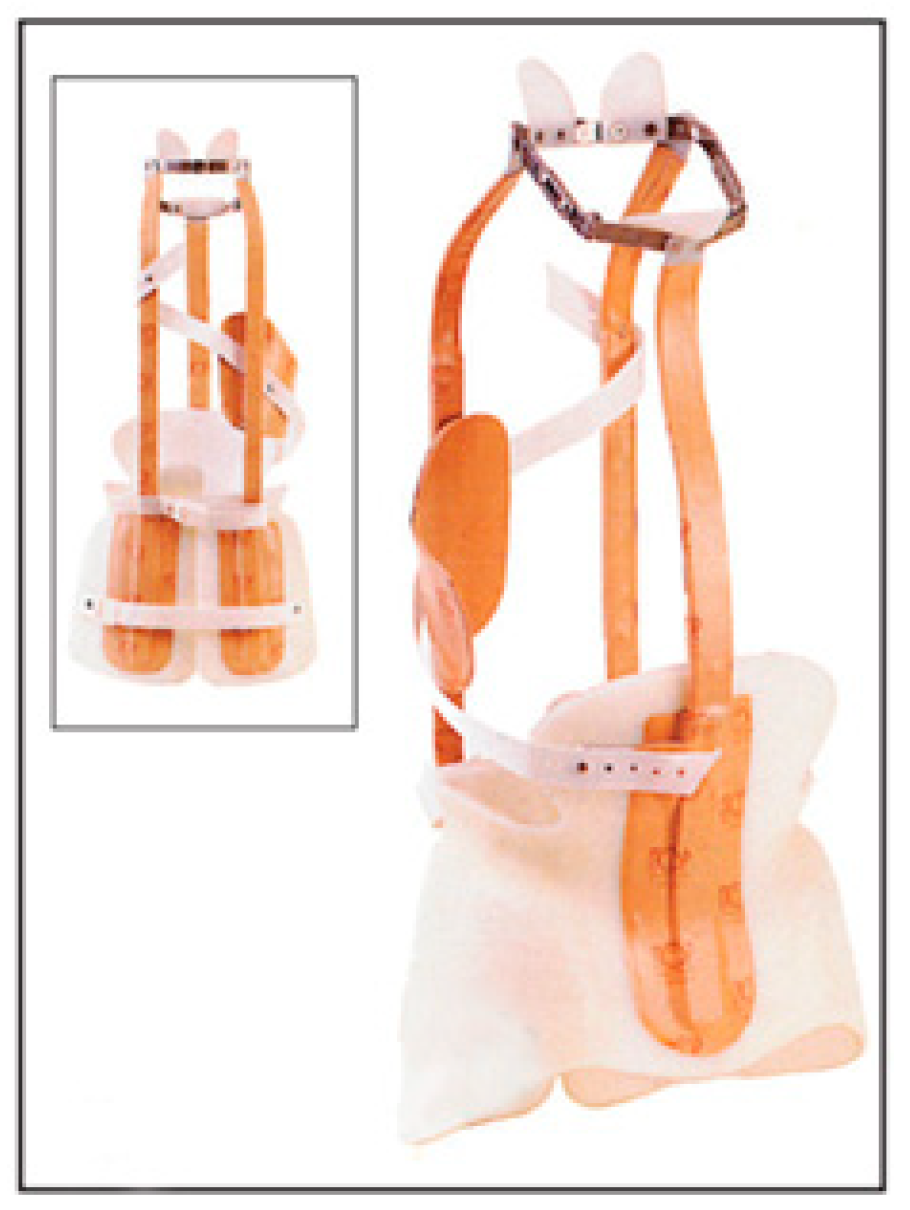
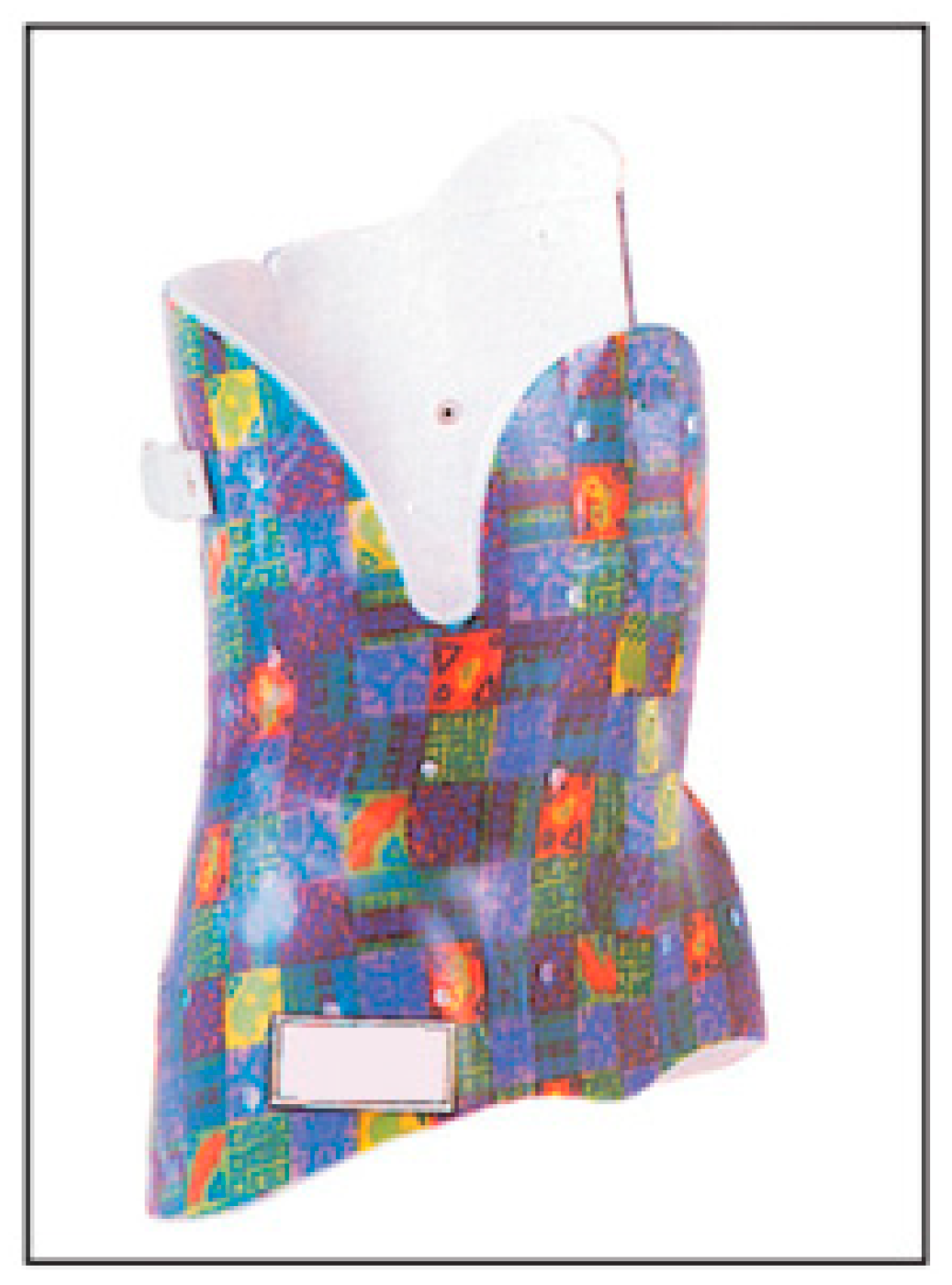
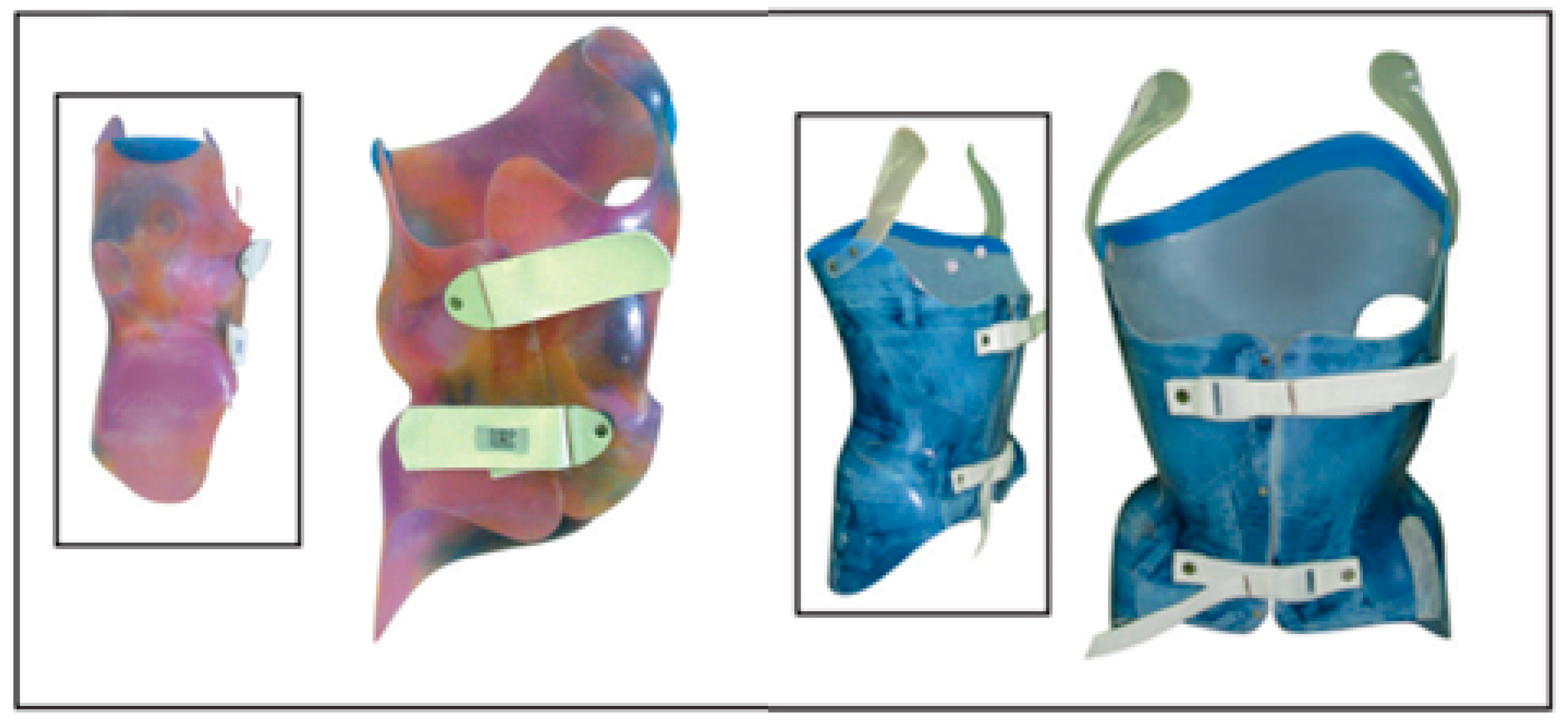
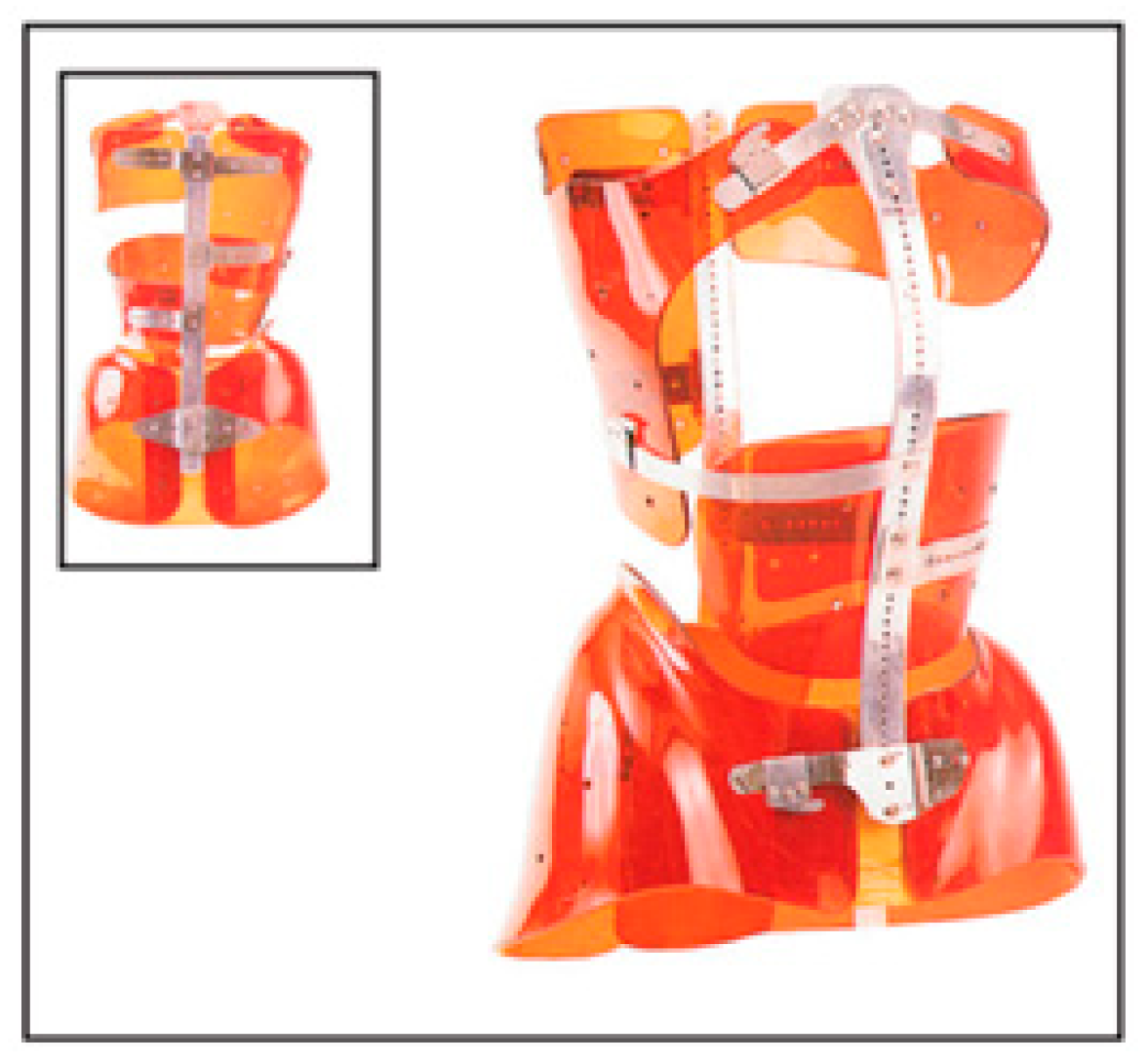
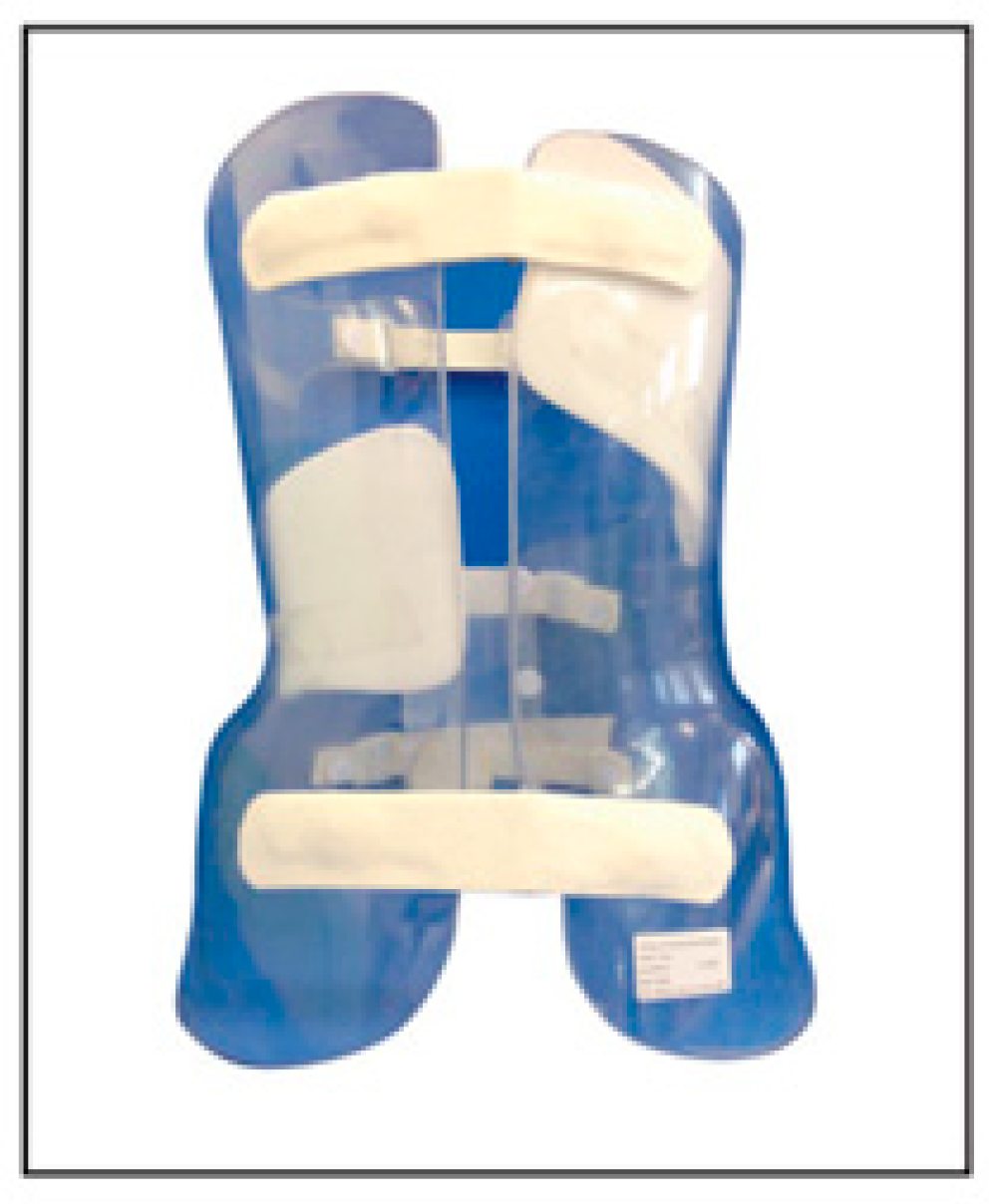
| Which age group wears the braces more? | 10–16 years [76] |
| Which brace is worn widely? | Boston brace [77] |
| What is the mean Cobb’s angle when a therapist suggests a particular brace for an individual? | 40–45° Milwaukee, 20–50° Boston, 25–45° Cheneau, 30–50° Lyon, Sforzesco |
| How many hours the braces were worn per day? | 23 h Milwaukee, 18–23 h Boston, 20–23 h Cheneau, 18–22 h Lyon, 18–23 h Sforzesco |
| Total treatment duration of wearing the brace. | 2–4 years [30] |
| Success rates after wearing the braces? | 48% (mean) Milwaukee, 72% Boston, 79% (mean) Cheneau, 88% (mean) Lyon, 78% (mean) Sforzesco |
Disclaimer/Publisher’s Note: The statements, opinions and data contained in all publications are solely those of the individual author(s) and contributor(s) and not of MDPI and/or the editor(s). MDPI and/or the editor(s) disclaim responsibility for any injury to people or property resulting from any ideas, methods, instructions or products referred to in the content. |
© 2023 by the authors. Licensee MDPI, Basel, Switzerland. This article is an open access article distributed under the terms and conditions of the Creative Commons Attribution (CC BY) license (https://creativecommons.org/licenses/by/4.0/).
Share and Cite
Del Prete, C.M.; Tarantino, D.; Viva, M.G.; Murgia, M.; Vergati, D.; Barassi, G.; Sparvieri, E.; Di Stanislao, E.; Perpetuini, D.; Russo, E.F.; et al. Spinal Orthosis in Adolescent Idiopathic Scoliosis: An Overview of the Braces Provided by the National Health Service in Italy. Medicina 2024, 60, 3. https://doi.org/10.3390/medicina60010003
Del Prete CM, Tarantino D, Viva MG, Murgia M, Vergati D, Barassi G, Sparvieri E, Di Stanislao E, Perpetuini D, Russo EF, et al. Spinal Orthosis in Adolescent Idiopathic Scoliosis: An Overview of the Braces Provided by the National Health Service in Italy. Medicina. 2024; 60(1):3. https://doi.org/10.3390/medicina60010003
Chicago/Turabian StyleDel Prete, Cristina Maria, Domiziano Tarantino, Mattia Giuseppe Viva, Massimiliano Murgia, Daniele Vergati, Giovanni Barassi, Eleonora Sparvieri, Eugenio Di Stanislao, David Perpetuini, Emanuele Francesco Russo, and et al. 2024. "Spinal Orthosis in Adolescent Idiopathic Scoliosis: An Overview of the Braces Provided by the National Health Service in Italy" Medicina 60, no. 1: 3. https://doi.org/10.3390/medicina60010003
APA StyleDel Prete, C. M., Tarantino, D., Viva, M. G., Murgia, M., Vergati, D., Barassi, G., Sparvieri, E., Di Stanislao, E., Perpetuini, D., Russo, E. F., Filoni, S., & Pellegrino, R. (2024). Spinal Orthosis in Adolescent Idiopathic Scoliosis: An Overview of the Braces Provided by the National Health Service in Italy. Medicina, 60(1), 3. https://doi.org/10.3390/medicina60010003











